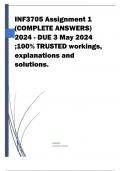INF3705 Assignment 1
(COMPLETE ANSWERS)
2024 - DUE 3 May 2024
;100% TRUSTED workings,
explanations and
solutions.
ADMIN
[COMPANY NAME]
, Question 1 [20 marks] Critically discuss the 5 levels involved in the process of
maturity model. Question 2 [10 marks] Suggest why it is important to make a
distinction between developing the user requirements and developing system
requirements in the requirement engineering process?
Sure, let's address each question:
Question 1: Critically discuss the 5 levels involved in the process of maturity model.
Maturity models are frameworks used to assess and improve the effectiveness and efficiency of
processes within an organization. The levels in a maturity model typically represent stages of
process improvement, with each level building upon the previous one. Let's discuss the five
levels often found in maturity models:
1. Initial: At this level, processes are usually ad hoc, chaotic, and unpredictable. There's little to no
formalization, and success depends heavily on individual efforts and heroics. Organizations at
this stage often lack consistency, and outcomes are highly variable.
2. Repeatable: In this stage, organizations start to establish basic processes. Key activities are
documented and standardized to some extent, allowing for consistent execution. However, these
processes might not be fully defined, and success can still rely heavily on individual knowledge
and experience.
3. Defined: At this level, organizations have well-defined and documented processes that are
consistently followed across the organization. There's a clear understanding of roles,
responsibilities, and procedures. Processes are tailored to fit the organization's needs, and there's
a focus on continuous improvement through measurement and analysis.
4. Managed: In this stage, organizations focus on data-driven decision-making and process
optimization. Performance metrics are established and monitored to track progress and identify
areas for improvement. Processes are actively managed, and deviations are addressed promptly
to prevent recurrence.
5. Optimized: The highest level of maturity, organizations at this stage continuously strive for
excellence. Processes are not only well-defined and managed but also constantly refined and
automated to achieve maximum efficiency and effectiveness. There's a culture of innovation, and
the organization is agile in responding to changes and opportunities.
Critically, while maturity models provide a structured approach to process improvement, they are
not one-size-fits-all. Organizations must carefully assess their unique needs, culture, and
constraints to determine the most suitable level of maturity to aim for and the appropriate
strategies for achieving it.
Question 2: Suggest why it is important to make a distinction between developing the user
requirements and developing system requirements in the requirement engineering
process?




